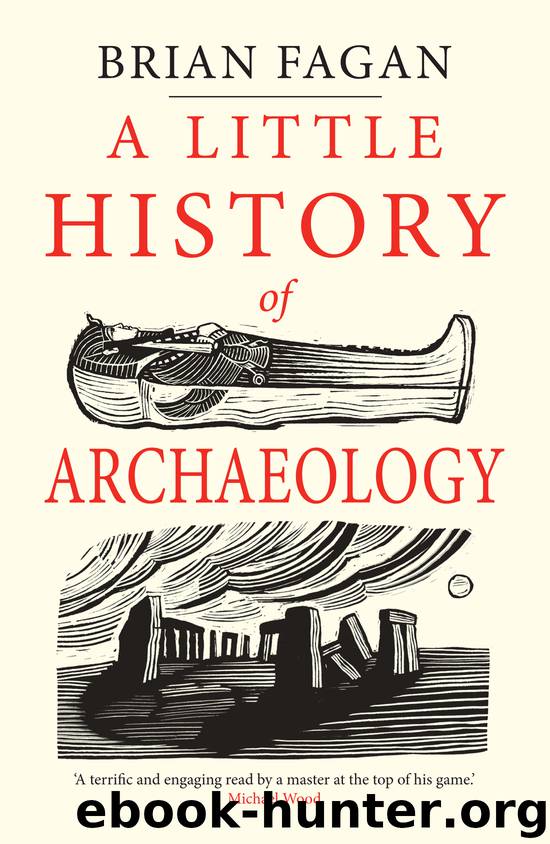Little History of Archaeology by Brian Fagan

Author:Brian Fagan
Language: eng
Format: epub
ISBN: 9780300224641
Publisher: Yale University Press
CHAPTER 22
A Palace Fit for a Chief
I slipped through a narrow entrance in the high stone enclosure and found myself in a tight passageway between an outer and an inner wall. I had no idea what lay inside. A conical tower of carefully laid stone blocks stood in front of me – a solid structure, with no doorway and no obvious purpose.
As I wandered through the jigsaw of masonry (stonework) and hut foundations inside Great Zimbabwe’s Great Enclosure, a feeling of confusion swept over me. I had spent much of the day visiting local African villages of thatched huts made of poles and clay. The contrast now was overwhelming. Why had farmers and herders living in such communities come together to build such a remarkable structure? It seemed a strangely alien and mysterious presence in the wooded landscape. There was no sign of great palaces or temples: only the imposing Great Enclosure stands high.
Great Zimbabwe occupies over 24 hectares. A large granite hill covered with enormous boulders overlooks a mishmash of stone structures, among them the Great Enclosure, the most prominent feature of the site. The hill, commonly known as the Acropolis (Greek: ‘high city’), is a maze of enclosures formed of boulders and stone walls. The largest of them – the Western Enclosure – was occupied for a long period of time.
The Great Enclosure is famous for its high, stone walls, built without mortar, and for its solid conical tower, which pokes just above the outer wall. The chief who ruled over Great Zimbabwe lived in this compound, probably isolated from his subjects. Several other smaller enclosures lie to the northwest.
But what exactly was Great Zimbabwe? Clearly, it was an important ritual centre. The Acropolis was a sacred hill isolated from the rest of the site. To judge from the various imported things like Indian glass beads, Chinese porcelain and seashells, the chiefs traded their gold, copper and elephant ivory with people from the East African coast.
We know that the men who lived here were chiefs because iron gongs – traditional symbols of African leadership – have been found in the Great Enclosure. Thanks to radiocarbon dating (see Chapter 27), we know that Great Zimbabwe flourished between about AD 950 and 1450. It was abandoned shortly before Portuguese ships arrived off the Indian Ocean coast in 1497.
The Portuguese sailed into coastal towns like Malindi and Mombasa in modern-day Kenya, which traded in ivory, gold and slaves from far inland. In 1505, they built a trading post at Sofala, a long-established Islamic trading station near the mouth of the Zambezi River. They found half-African merchants who would lead small parties upriver and into the highlands of the interior, carrying cheap Indian cloth, strings of colourful glass beads and seashells. In exchange, the traders obtained gold dust carried in porcupine quills, copper ingots and, above all, elephant tusks.
Some of the traded goods, such as Chinese porcelain and cloth, reached Great Zimbabwe. From their sporadic explorations inland, the Portuguese learned of a settlement built of stone, but never visited it.
Download
This site does not store any files on its server. We only index and link to content provided by other sites. Please contact the content providers to delete copyright contents if any and email us, we'll remove relevant links or contents immediately.
| Anthropology | Archaeology |
| Philosophy | Politics & Government |
| Social Sciences | Sociology |
| Women's Studies |
Mysteries by Colin Wilson(2889)
People of the Earth: An Introduction to World Prehistory by Dr. Brian Fagan & Nadia Durrani(2349)
Ancient Worlds by Michael Scott(2107)
Foreign Devils on the Silk Road: The Search for the Lost Treasures of Central Asia by Peter Hopkirk(2057)
The Memory Code by Lynne Kelly(1950)
Lost Technologies of Ancient Egypt by Christopher Dunn(1803)
The Splendid and the Vile by Erik Larson(1787)
Come, Tell Me How You Live by Mallowan Agatha Christie(1771)
The Earth Chronicles Handbook by Zecharia Sitchin(1750)
The Plantagenets by Dan Jones(1617)
Last Chance to See by Douglas Adams(1601)
The Return of the Gods by Erich von Daniken(1575)
Wars of the Anunnaki by Chris H. Hardy(1392)
Before the Dawn by Nicholas Wade(1317)
Keeper of Genesis by Graham Hancock(1280)
The Cygnus Mystery by Andrew Collins(1259)
The Message of the Sphinx by Graham Hancock(1226)
Fragile Lives by Stephen Westaby(1118)
Hieroglyphs: A Very Short Introduction by Penelope Wilson(1037)
